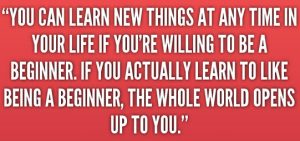 There’s so much you want to learn, need to learn, should learn… so much, in fact, that you don’t know where to start.
There’s so much you want to learn, need to learn, should learn… so much, in fact, that you don’t know where to start.
Most people get inspired for some goal, sprint at max effort for 1-2 weeks, burn out, push the goal into the back of their mind, and never touch it again. New Year’s resolutions are a classic example. Campaigning.
Let’s look at how to improve your chances of success.
- First things first—check your bases.
The first thing you should do is touch base with yourself. Ask: “Is what I want what I want?”
I know that is a funky question… of course… but ask it anyway! It may not be necessarily so!
Sometimes, we lie to ourselves about what we want. Other times, we are being deceived and we don’t even know it. We might want to do something because of vanity, because our neighbors are doing it, because of our self-identity, or because of some long-held ‘dream’ from childhood.
Begin by doubting yourself. Find the things you actually want – not the things you say you want. It will save a lot of time on the long run.
- Reflect and make space.
Next, you need to make space. Before you decided to change, your day is already full. You slept, ate, work and did stuff — 24 hours a day, every day. To make room for new things, something else will have to go. There is always a sacrifice.
In an ideal world, we would surgically remove bad habits, activities, people that are least in line with our goals and add in only those things most in line with the goals. Sadly, behavioral change isn’t quite that precise. But that doesn’t mean we can’t be systematic about it.
Here’s how I’d do make space for the new:
- 1. Track. Figure out what your typical day looks like: when you woke up, when you went to work, how many hours you spent on task A, B, C, etc. and what time you went to sleep.
- 2. Dissect. Figure out what you can sacrifice. Are you wasting time on the Internet? Are there low-quality people in your life? What are the 10-20% of activities that are making up 80%+ of your empty, meaningless time reducing your productivity to 20%? Remember the Pareto principle?
- 3. Replace. Notice I didn’t say add. Adding is hard — you are already using all 24 hours, remember? the basic protocol is: (1) identify the trigger for the activity or habit you want to replace, (2) spend 1-2 weeks “re-programming” that trigger to your new, more beneficial activity.
Again, remember that making space is hard. You will only be able to do one new thing, two at most.
Choose the most important thing, spend 1-2 weeks making that practice into a habit, then repeat the above process for new changes you want to make.
How to choose the “most important thing?” By choosing the lead domino.
Choose the lead domino.
I heard of this concept from Tim Ferriss. When you have a lot of interesting things ahead of you and you don’t know what to choose, choose the thing that makes everything easier. If you want to run a marathon, you might want to start by quitting smoking first. If you want to be a martial artist, you might want to “bulletproof” your joints against injury so you can train harder.
This will require an exercise in awareness. You need to be able to see second order and third order effects — how certain skills, habits and life changes cascade into future changes and how those future changes keep snowballing into even more changes down the line.
A few more tools before you go.
- Aim for a 80% success rate. Humans learn best when they are optimally challenged. This happens somewhere around 80%. Keep track of your weekly practice goals, and aim to achieve them 5-6 days a week. If you had a perfect week, maybe it’s time to add some more challenge to your life.
- Work in phases. When you’ve spent 4-6 weeks on some skill, have seen considerable improvement, and progress has slowed, it makes sense to put that skill aside to work on a new one. Even better if this new skill has synergistic relationship with the old one. Maybe you were working on writing and now you’re going to work on public speaking. Maybe you take a break from dance to work on yoga.
- Put skills on maintenance. Hidden law of the universe: changing is a lot harder than staying the same. Useful side effect of this law of the universe: putting skills on maintenance requires very little effort. This is why athletes can retain muscle mass despite dropping training to 10% of previous levels. This is why someone can still speak Japanese despite working on it much less than they used to.
It takes very little, maybe 15 minutes 3 times a week, to maintain a skill. This prevents regression, which is costly. Forgetting a language and then relearning it costs a lot more than keeping it on maintenance.
- Deload. This is another concept from athletic training. Most high level athletes halve the amount of training they do every 4-6 weeks. This gives the body a chance to recover from pent-up stress and actually produces a wave of “super compensation” where the athlete reaps all the benefits from training during that rest and recovery period.
Try scheduling reloads for your own daily practice. Let to subconscious do its work. Go on vacation every one or two months. Take a day off. Read some fiction. You might find it easier to concentrate after you come back.
Source: https://web.archive.org/web/20170502191036/http://marketmeditations.com:80/how-to-learn-many-things-at-once-and-stay-sane-doing-it/
